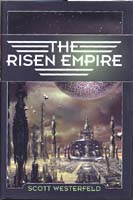 The
Risen Empire
The
Risen Empire
by Scott Westerfeld
A book review by Mark L. Olson
Tor, 2003, $24.95, 304 pp
Westerfeld isn't a new writer, but this is the first thing I've read by him and it's a fine hard SF novel – there's really quite a nice renaissance going on here!
The story is set thousand of years in the future in a galaxy filled with human worlds and filled with human polities. Interstellar travel, while limited to light-speed, is routine. Limited FTL communications exists and is in use.
The Risen Empire is a odd collection of eighty or so worlds ruled by the man who discovered the only practical method of immortality, a symbiote which in some unclear fashion preserves the body and mind after death (if the death isn't too messy or destructive). These people – called the Risen – are somewhat like zombies (they're dead, after all) but are completely their own masters and not controlled by anyone else.
Nonetheless, for reasons which are not yet clear to me, nearly all of them retire after they die, forming the Gray population which controls a huge fraction of the wealth of the Empire, but participate only in a very limited way in public life.
The excitement in the story centers around a hostage crisis on a border world where Rix commandos have captured the Empress and are holding her hostage while they infiltrate the planet's electronic infrastructure. The Rix are heavily cyborged, and worship the intelligences which naturally arise in any sufficiently complex computer network. Most worlds (including those of the Risen Empire) take active steps to suppress the rise of network intelligences, while the Rix try to seed other planets' networks. Once an intelligence has fully emerged, it can't be shut down short of completely shutting down the network and scrubbing each machine – think of it as immanent in a particularly hard-to-stop virus. (It's unclear that these intelligences are inimical or even harmful to people, but most people don't like them, anyway.)
The young warship captain who is nearby and who must deal with the situation is one of the centers of the story, along with his lover, the leader of one of the Empire's Senate's parties.
Westerfeld has developed some interesting notions about how a STL empire possessing immortality for some would be governed. Events in the empire as a whole have a longish timescale, since, while news of an event at the border gets to the capital instantly, it takes up to thirty years for any physical response to get there.
The Senate exists as a curb to the power of the Emperor. (This is an example of Westerfeld's good sense. It's all good, harmless fun to imagine feudal empires in space, but we understand enough now to know why totalitarian societies don't do as well as more democratic ones and we can be fairly sure that in the long run, Emperors – even undead emperors – will turn more and more into figureheads.)
Since the senators are still alive, and since they represent planets many years away in space, their terms are fifty years and they spend 80% or so of their time in suspended animation. This gives the senators an effective lifespan to match the long, slow, pace of events in the Empire and to match the Emperor's longevity. (I have my doubts about this scheme, though. Politics is about interpersonal relationships amongst the politicians as much as anything, and there will always be a short-term advantage to some senators staying awake longer than the others. I honestly can't see a political body going into suspended animation.)
Westerfeld also understands the ill effects of a class of immortals running a society. When the Risen Empire was founded 1600 years previously, it was the technological leader; by now, it has slowly fallen behind and its technology is more than a bit obsolete by galactic standards. Thoughtful people in the Risen Empire worry about this.
There's a lot of jumping back and forth in time as chapters alternate between today's political crisis and the early days when the captain and the senator first met. The love story between the two is plausible (they're well-matched with the senator's suspended animation keeping her aging in line with the starship captain's time dilation) and their involvement in the hostage crisis is well-handled.
All in all, this is a fine story. There is evidently a sequel coming and I'm looking forward to it.
NESFA homepage | Review Index | More Reviews by Mark L. Olson
